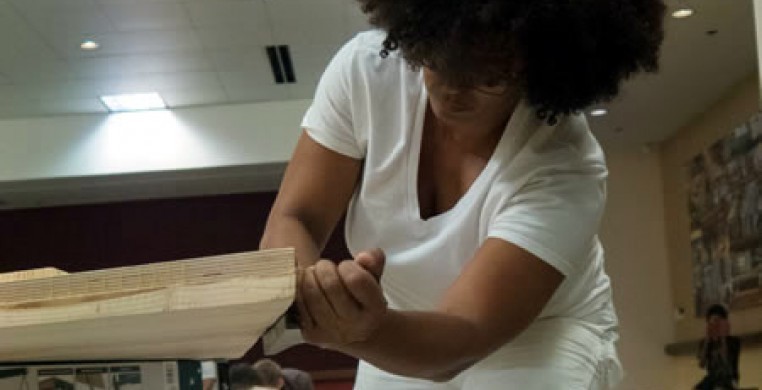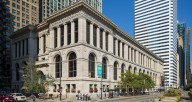Through Feb. 8, “Project Tool” is an art and movement installation in the Garland Gallery on the main floor of the Chicago Cultural Center. The exhibit highlights the year-long process by which choreographer and Chicago Dancemakers Forum (CDF) Lab Artist Onye Ozuzu and a team of collaborators built hexagonal, semi-portable, sprung wood dance floors, and a dance to go upon and around them. Designed by artist Steve Silber with additional support from Bryan Saner, each half-hexagon (of which about 12 are fully built) is arranged like a honeycomb to create a small, danceable surface at the entry to the Garland Gallery.
This building process has been documented in an elegant photo wall (Petra Probstner) perpendicular to the dancing space, across from which is a wall of tools mounted over written sentiments from gallery visitors. The space is quite tight, with performance areas and audience gathering places restricted by a tesseract – a room within the room called “the sanctuary,” within which is a small performance platform set in front of video images by Jovan Landry, and outlines on one wall of each performer’s body (Ozuzu, Keisha Bennett, Keyierra Collins, Jessica Marasa, and Anna Martine Whitehead).
These outlines, labelled by name, are drawn around coat hooks donning white articles of clothing. While all of these elements are part of the two-week exhibit, “Project Tool” offered just two chances (Feb. 2 and 3) to witness how Ozuzu’s process of building this essential resource – a dancer’s floor – manifested in the body to create a live performance.
Anthropologists learn about the behaviors of ancient peoples by investigating their tools. The use of blades, arrows, and hammers allowed humans to dominate animals. The advent of guns, missiles, and nuclear weapons allowed certain humans to exert dominance over others. Occupational tools facilitate hunting, farming, and building, providing an extension of the body that makes their work possible, and more efficient. And though the body is the dancer’s primary instrument, the floor is her tool.
So, part of the goal of “Project Tool” has been for Ozuzu to command a certain degree of agency by gaining the skills to literally build the ground beneath dancers’ feet, allowing dance to happen (safely) anywhere. And some of their performed movements reference physical labor – gathering, smoothing, chopping, directing, slicing – repeating these task-based movements over and over with increasing speed until pretty much forced to stop from exhaustion. They would then periodically retreat to the sanctuary, trading one white outfit for another, or abandon dancing altogether for a mostly voiceless demonstration of the floor building process.
The “dancier” moments of the work make references to community, history, or ancestry, the best of which include Collins’ stationary solo – which imitated flight or levity – followed by her careful watching and mimicking of Bennett’s equally buoyant (I embarrassingly had a mental image of those inflatable air dancers you might see at a car wash), but distinctly different solo. Simultaneously, on the other side of the sanctuary, and complemented by a glorious electronic drone and the twinkling of wind chimes mixed live by musician/composer Damon Locks, Whitehead travelled by foot without touching the ground. Ozuzu slowly writhed beneath her, forming a floor on which to walk, becoming the tool she has studied for a year.
While those moments felt essential, others didn’t, most notably a long period of arduous contact improv and a very choreographed, superfluous “dance break” at the end of the work. The performers moved on and off the honeycomb of dance floors without ceremony, which made me question to what extent this essential tool was… essential. But the greatest irony of “Project Tool,” is that while the work is wholly, ingeniously connected to a sense of practicality, necessity, and utility, decisions about the audience experience lacked all of those. With only two chances to witness the live performance of this work, the gallery was justifiably packed, forcing guests to get really cozy in what turned out to be an awkwardly configured, uncomfortable space. Some guests opted to simply accept that they weren’t going to see everything, and it helped to be tall, or willing to sit on the floor, or brave/pushy. With only the first of those in my favor, I came away feeling a bit cheated– as if all this great stuff was happening around the corner and I just couldn’t see it.
“Project Tool” is free to the public and open weekdays 10 a.m. to 7 p.m. and weekends 10 a.m. to 5 p.m. through Feb. 8 in the Garland Gallery at the Chicago Cultural Center, 78 E. Washington St. For more information, visit ozuzudances.com.
Lauren Warnecke is the dance writer and critic for the Chicago Tribune.



